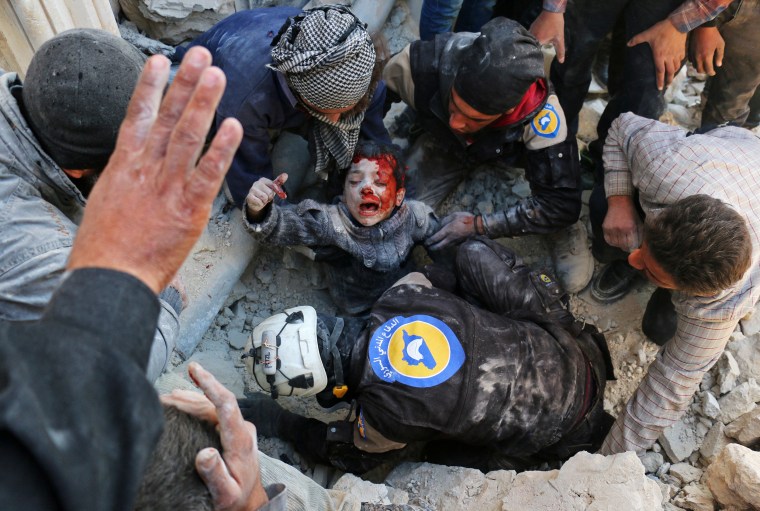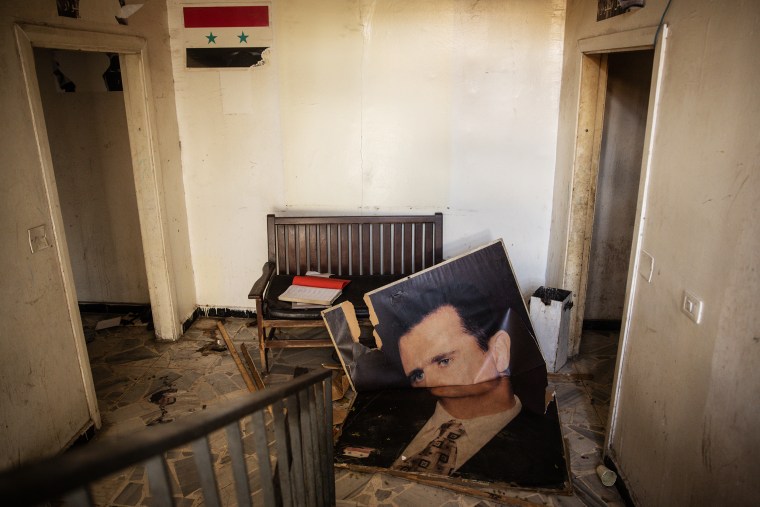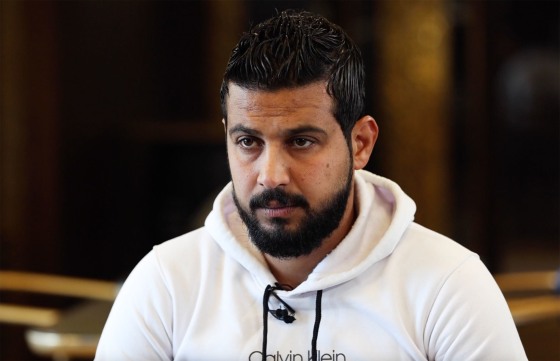DAMASCUS, Syria — It was a small act of teenage defiance that sparked a revolution, a moment forever inscribed in Syrian history.
When 15-year-old Mouawiya Syasneh and a group of classmates from Daraa sprayed the words “It’s your turn, Doctor” on the wall of their school, the reference to dictator Bashar al-Assad would become inextricably linked with a 13-year civil war.
Now 30, Syasneh, told NBC News in an interview in Damascus that the night Assad’s regime finally fell, he drove from southern Syria to the country’s capital to see the revolution come full circle with his own eyes.
“I remembered when I was in prison 14 years ago when the regime arrested us and tortured us,” he said, adding that he didn’t like to recall those dark days. Now, he said, he was once again hopeful for his country.
Syasneh, who is now married with a 6-year-old son, was detained along with at least 15 other boys, triggering outrage over their mistreatment. Protests spread across the country and would ultimately morph into a bloody and brutal conflict — killing hundreds of thousands of people, displacing half the prewar population of 22 million, and wiping out Syria’s economy.

Inspired by the Arab Spring protests that had toppled dictators in Tunisia and Egypt, Syasneh and his friends wanted to send a message about their frustration with the constant police patrols in Daraa, a sleepy town near Syria’s southern border with Jordan.
In March 2011, he said, he sprayed the graffiti referring to Assad’s training in Britain as an ophthalmologist. A number of the boys had “written our names on the school wall, not just the slogans,” he said, adding: “We were young and did not expect to face what we faced.”
It would prove a fateful decision.
Fearful that Syria would see sustained street demonstrations similar to those in countries across North Africa and the Middle East, security forces loyal to Assad — whose family had ruled Syria for more than four decades at that time — were on edge and keeping watch for even the smallest signs of dissent.
So, when the feared Mukhabarat, or Syrian intelligence, got wind of the graffiti and saw the names written nearby, “they arrested everyone who had written their name on the school wall,” Syasneh says.
Interrogations quickly turned into “unbearable” torture, he said, “including electric shocks and beatings.” On one occasion, he was tied and hung “like a chicken in a roasting machine,” he added.
“Because we were children, we could not endure the torture,” he said.
What he didn’t know at the time was that outside Daraa’s al-Omari Mosque, thousands of people had started to gather regularly to protest for their release.
They were met with a brutal response from security forces who shot demonstrators with live ammunition, reportedly killing two of them in what activists regard as the first deaths of the uprising.
This in turn led to larger, more violent clashes across Syria, and by the time the military, backed by tanks and snipers, rolled into Daraa the following month, the demonstrations had spread like wildfire across Syria, followed by a vicious crackdown.
“They told our families to forget about us when they asked about us,” Syasneh said, adding that he only found out that people across southern Syria had been “holding peaceful demonstrations” after his release from prison.
Released after 45 days, Syasneh said he fled to neighboring Jordan as a refugee.
When he returned the following year, Assad was at war with his own people.

After his father was killed by a rocket attack in 2013 as he walked to the mosque, Syasneh said he decided to pick up a weapon and fight with the Free Syrian Army, a loose coalition of rebel groups made up mainly of army deserters.
“I lost someone dear to me, my father, who became a martyr,” he said, adding that he wanted to “carry arms to defend my land, my country, and my honor.”
As time ticked by, the conflict became more complex as foreign powers like Russia and Iran offered support to Assad’s government, while the U.S., Arab Gulf countries and Turkey backed some of the rebel groups. The Kurds — a stateless ethnic group concentrated in Syria, Iran and Iraq — also intervened, while extremist groups like the Islamic State also started to grow in stature, weaving a web of warring parties.
The U.S. was among the countries to send troops to fight ISIS, which exploited the instability to expand its self-declared caliphate’s territory and also provided support to the Kurdish-led Syrian Democratic Forces in its battle against the militants.
In December, the Pentagon announced that roughly 2,000 troops were deployed to Syria, more than double the number the military had said for years, about 900.
Syasneh said that during his time as a rebel, they would capture soldiers or “they would turn themselves and their weapons over to us, and we would keep them with us.”
Until late last year, the conflict had seemingly frozen, with Assad in control of parts of the country and various factions ruling in other parts of the country.
But then it exploded back into action late last year when, in just under two weeks, the Hayat Tahrir al-Sham group, known as HTS — along with an umbrella group of Turkish-backed militias — swept south through Syria before taking the capital, Damascus, and forcing the fall of the Assad government.
Since then, around 200,000 Syrian refugees have returned home from neighboring countries, according to the United Nations, but Syasneh said many are still afraid to come back.
“They want the situation to improve before coming back; they have no homes or anything else, so where would they return to?” he said, adding that he was hopeful that a new government, led by Syria’s de facto leader Ahmad al-Sharaa, will now begin the process of rebuilding a nation devastated by the war.
“We strive to form a state and to rebuild a new Syria, making it better than before,” he said. “We want to live in security and safety and to maintain our dignity; this is the most important thing for us,” he added.

But the cost of rebuilding remains colossal. The estimated cost “ranges between $250 billion and $400 billion — figures that, given the extensive damage to the country’s infrastructure, appear increasingly accurate,” reads a January report from the Atlantic Council, a Washington-based think tank.
“We are betting on this matter and asking countries to help us in rebuilding Syria because it is completely destroyed,” Syasneh said.
Like many who fought for Assad’s ouster, he added that he did not believe the Syrian revolution would end until Russia, which is sheltering the dictator, handed him over to the new government in Syria.
“We want to hold Bashar al-Assad accountable as a war criminal,” he said. “He slaughtered thousands of prisoners and buried them underground, then paved over them to hide his crimes so that the world would not know what was happening here.”
Now a father himself, he added that stories of his rebellion as a teenager have inspired his son, currently in kindergarten, to fight for a free Syria.
“When you ask him what he wants to do, he replies that he wants to write on the walls,” he said.
Hala Gorani and Briony Sowden reported from Damascus. Astha Rajvanshi reported from London.
